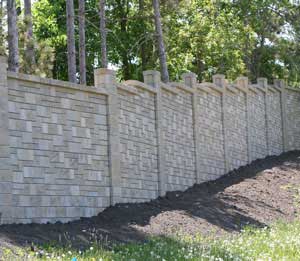Design Tables

Sound Barrier Fence
The following concrete fence design tables provide specific structural estimates for different wind loads and soil types for an Allan Block Fence. These tables provide an accurate estimate for fence design in non-hurricane prone areas. To use these tables follow these simple steps:
- Verify site conditions for wind speed and soil conditions.
- Identify the 50-year average wind speed where your project is located. Reference the Uniform Building Code or Appendix C of the National Building Code of Canada that provides a 1/50 hourly wind pressure that can be used.
- Select a type of exposure based on the following classification:
- Exposure B: Surface roughness consisting of urban and suburban areas, wooded areas, or other terrain with numerous closely spaced obstructions having the size of a single family dwelling or larger.
- Exposure C: Surface roughness consisting of open terrain with scattered obstructions having heights generally less than 30 ft (9.1 m) extending ½-mile (805 m) or more from the site. This category includes flat open country, grasslands, and bodies of water under 1-mile (1.6 km) in width.
- Exposure D: Describes the most severe exposure with surface roughness consisting of flat, unobstructed areas and bodies of water over 1-mile (1.6 km) in width. Exposure D extends inland from the shoreline ¼-mile (0.4 km).
| Wind Loads | |||
| Exposures | 70 MPH | 80 MPH | 90 MPH |
| B | B-70 | B-80 | B-90 |
| C | C-70 | C-80 | C-90 |
| D | D-70 | D-80 | D-90 |
- Match values from steps 2 and 3 to Wind Load table
- Locate your particular load condition in the following design tables and find the pile depth, maximum post spacing, steel schedule and bond beam design.
For more information see AB Fence Tech Sheet for Wind Speeds and Pressures.

